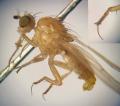Diptera.info :: Identification queries :: Other insects, spiders, etc.
|
Sand worm
|
|
| Muhammad Mahdi |
Posted on 05-06-2009 21:15
|
|
Member Location: Dar es Salaam, Tanzania Posts: 447 Joined: 26.12.08 |
A very small worm like insect living in this samll sand like house(?) It could take its head out from either end. App 2mm length of head Muhammad Mahdi attached the following image:  [22.58Kb] Muhammad ____________________ www.micro2macro.net |
| pwalter |
Posted on 05-06-2009 22:08
|
|
Member Location: Miskolc, Hungary Posts: 3555 Joined: 06.11.08 |
Lepidoptera, Psychidae? |
|
|
|
| Muhammad Mahdi |
Posted on 07-06-2009 07:28
|
|
Member Location: Dar es Salaam, Tanzania Posts: 447 Joined: 26.12.08 |
Wow. Thanks
Muhammad ____________________ www.micro2macro.net |
| Tony Irwin |
Posted on 07-06-2009 08:17
|
|
Member Location: Norwich, England Posts: 7320 Joined: 19.11.04 |
I think this is more like Tineidae - being able to turn around in the case is something I know they can do - not sure that Psychidae can do this. Also the shape of the caterpillar is more like Tineidae.
Tony ---------- Tony Irwin |
|
|
|
| Muhammad Mahdi |
Posted on 07-06-2009 20:34
|
|
Member Location: Dar es Salaam, Tanzania Posts: 447 Joined: 26.12.08 |
Take yr word for it. Thanks Tony. Anyway, just wanted some basic info about the interesting creature. Muhammad ____________________ www.micro2macro.net |
| Tony Irwin |
Posted on 07-06-2009 21:21
|
|
Member Location: Norwich, England Posts: 7320 Joined: 19.11.04 |
The narrow body seems to be an adaption to being able to turn round inside their case. The case is partly for camouflage (being made of whatever material they are living on), and also offers some protection against parasites. A related species - Tinea pellionella - is the "Case-bearing clothes moth" - a serious pest in museums in Europe, where it eats hair and feathers of stuffed mammals and birds  , as well as wool carpets and furnishings in old houses. , as well as wool carpets and furnishings in old houses.
Tony ---------- Tony Irwin |
|
|
|
| Muhammad Mahdi |
Posted on 08-06-2009 05:30
|
|
Member Location: Dar es Salaam, Tanzania Posts: 447 Joined: 26.12.08 |
So once they grow, they come out of their cases and leave them behind? I have seen many of these empty sand cases around. Muhammad ____________________ www.micro2macro.net |
| Tony Irwin |
Posted on 08-06-2009 07:49
|
|
Member Location: Norwich, England Posts: 7320 Joined: 19.11.04 |
Each time they shed their skin, they make the case a bit bigger. Finally they pupate inside it and the adult moth emerges leaving the empty pupal skin behind in the case (sometimes it sticks out of one end). The cases can look as though they are empty - sometimes they will be, but sometimes they contain the resting pupa.
Tony ---------- Tony Irwin |
|
|
|
| Jump to Forum: |













